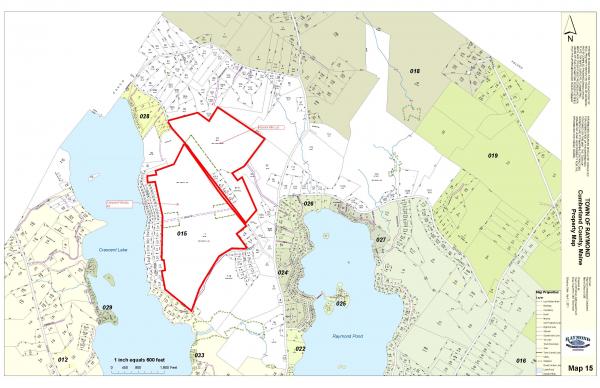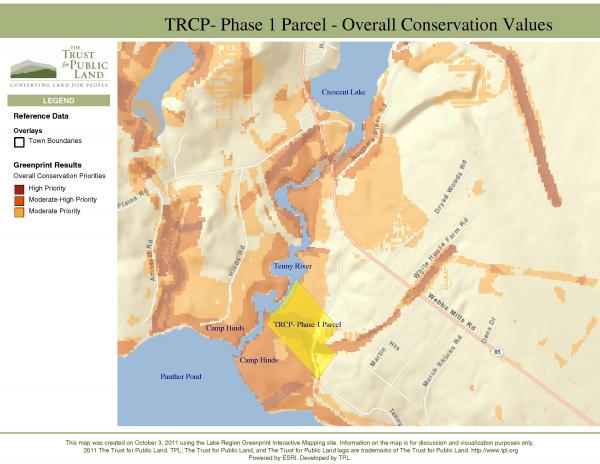Raymond Community Forest
Tenny River Corridor Project
The Raymond Community Forest Proposal was presented to the Raymond Board of Selectmen on August 14, 2012. The presentation and handout detailed the 347 +/- acres of forestland in North Raymond located on Conesca Road owned by Hancock Land Company (HLC) that includes level to gently sloping land between the road and Crescent Lake, and Pismire Mountain on the north side of the road (see attached Map). The presentation described the Raymond Conservation Commission’s (RCC) interest in the property since 2007 and recent communications with Loon Echo Land Trust (LELT) and HLC to advance a potential community forest project. (Click for larger image)
The Selectmen asked for more information, mainly on the strategy (how to secure the land), project budget, ownership and potential income sources that the property may provide in the long term. Since then the RCC and LELT have met on several occasions to advance these issues, including an estimate of sustainable timber harvest revenue, to have a definite proposal to the Selectmen.
LELT and the RCC are to meet with the Selectmen on May 14, 2013 to discuss the details of the proposal. This survey has been prepared to get a preliminary reading from the community on the interest in this project. Please complete the following survey to the best of your ability. The results will be shared with the Selectmen and will help all parties decide if this is a viable project for the town.
Take survey HERE
Watch the Informational video HERE
Thanks for your input – it is important for the town and community !
Raymond Conservation Commission
For more information contact:
John Rand, RCC Chair
Tenny River Corridor Protection Project
(As presented to the Board of Selectmen on March, 2012)
Purpose
We are requesting $10,000 towards a total project cost of $226,000 to help purchase 32 acres of land along the Tenny River in Raymond Maine. This is Phase 1 of a larger planned effort to preserve all of the land along both sides of the mile-long river, which flows between Crescent Lake and Panther Pond. The land to be purchased abuts Camp Hinds, the flagship campus of the Pine Tree Council (PTC) of the Boys Scouts of America. The PTC signed a purchase and sale agreement with the seller in August 2011. The land had been on the market, is zoned for two-acre house lots, and the seller was motivated; he had partially cleared one building lot on the river to enhance its marketability. There is clear danger of residential development. (Click map for larger image).
Expected Results
The Tenny River Corridor Protection Project will preserve habitat, protect water quality, and expand availability of low-impact recreational opportunities. The PTC will negotiate a conservation easement with Loon Echo Land Trust to help protect the land in perpetuity. The shallow, slow moving Tenny is home to a wide range of fish, birds, and other wildlife, including redbreast sunfish, bullhead and largemouth bass, heron, loons, painter and snapping turtles, and butterflies, and many others. Grasses and reeds along the sides of the boating channel provide shelter for young fish and other aquatic life. The woods along the banks provide shade, and filter runoff that could harm water quality. Since the Tenny is part of the Casco Bay watershed, this is a vital contribution. The land along the river is also part of the recharge area for the aquifers supplying the Lakes Region.
In 2010 the Loon Echo Land Trust, the Trust for Public Land, and many other communities and stakeholders completed a “Greenprint” for the Lakes Region, to identify the lands that contribute most to quality of life and
should be protected (see http://loonecholandtrust.org/html/lake_region_greenprint.html for more information about this process). The Greenprint identified seven goals; the top two priorities were protecting water resources and preserving plant and animal habitat. As the attached map illustrates, the land bordering the Tenny is listed as
high priority for protection of water resources, and very high/high on the map for preserving plant and animal habitat. Acquiring the land along the Tenny, starting with this first parcel, will help make measurable progress towards the goals identified in the Greenprint.
Lake residents and visitors travel through the Tenny to enjoy its natural beauty, and to explore or fish in the lakes on either end. A public boat launch on the southern end of Crescent Lake, right by the northern tip of the Tenny, allows for public access as well. The volunteer boat inspectors at the Crescent Lake launch estimate that
approximately one-third of the 610 boats they counted on weekends between Memorial Day and Labor Day went through the Tenny. Finally, each year 5,700 youth come to Camp Hinds for summer programs, camporees, and other special programming, assisted by over 3,450 adults. The Tenny features prominently in Camp Hinds’
programming. The land purchase will protect land abutting Camp Hinds, providing a buffer from residential development, and preserving the pocket of wildness that for many Scouts is their first introduction to Maine’s unparalleled outdoor recreation opportunities.
How Results will be Measured
In the next 18 months, we will measure results by the following methods:
- Tracking progress towards fundraising goals, including private, foundation, and corporate contributions that allow us to complete the purchase of the first parcel by the 2014 deadline. Other funding will come from a combination of private, foundation and corporate contributions. Already, a group of Panther Pond landowners have contributed $70,000 towards the purchase.
- Negotiating and signing the conservation easement with Loon Echo Land Trust.
- Securing a purchase and sale agreement with another Tenny River property owner who has already signaled her interest in selling the parcel (Phase 2). Opening discussions with the final Tenny River landowner around acquiring that property, and signing an option or a purchase and sale agreement to secure that parcel (Phase 3).


